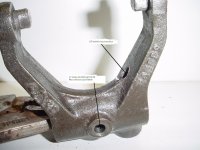BritBox
Jedi Hopeful
Offline
Hi,
I guess it's my turn to have clutch issues with my TR250. It went from OK to pretty bad in just a few drives: initially had trouble with reverse, then getting into first from a dead stop. Bled the heck out of it and it is better, but reverse is still not really there. When I'm under there bleeding it I can see good action with the slave pushrod.
Some background: the car has about 20,000 miles on a pretty complete restoration. Motor internals are original. Gearbox totally rebuilt, flywheel lightly skimmed and balanced, Toyota Landcruiser throwout bearing, Sachs pressure plate, B&B friction disk. New fork and shaft, with second bolt pinning the fork. New slave cylinder, rebuilt master.
I had a similar problem about a year and a half ago. I ended up removing the "new" orange plastic flexible line between the master and slave, and replacing it with a nylon/stainless steel upgraded hose. Problem solved.
Question: In spite of what LOOKS like good hydraulic actuation, should I still suspect the master and/or slave? Or my new fancy flexible line? I'm sure I'd rather throw some parts at it before I bust the whole thing apart. Or should I suspect the dreaded fork pinch-bolt, even though I modded mine? I suppose that stranger things have happened. It "feels" fine to the foot, so to speak, for whatever that's worth. If the fork was broken it would be more consistently broken, wouldn't it?
If I pull it all out, I guess that's a good reason to finish the spare used motor with the fresh bearings and other new bits...
Any and all suggestions or comments welcome; thanks for reading this far!
Thanks,
I guess it's my turn to have clutch issues with my TR250. It went from OK to pretty bad in just a few drives: initially had trouble with reverse, then getting into first from a dead stop. Bled the heck out of it and it is better, but reverse is still not really there. When I'm under there bleeding it I can see good action with the slave pushrod.
Some background: the car has about 20,000 miles on a pretty complete restoration. Motor internals are original. Gearbox totally rebuilt, flywheel lightly skimmed and balanced, Toyota Landcruiser throwout bearing, Sachs pressure plate, B&B friction disk. New fork and shaft, with second bolt pinning the fork. New slave cylinder, rebuilt master.
I had a similar problem about a year and a half ago. I ended up removing the "new" orange plastic flexible line between the master and slave, and replacing it with a nylon/stainless steel upgraded hose. Problem solved.
Question: In spite of what LOOKS like good hydraulic actuation, should I still suspect the master and/or slave? Or my new fancy flexible line? I'm sure I'd rather throw some parts at it before I bust the whole thing apart. Or should I suspect the dreaded fork pinch-bolt, even though I modded mine? I suppose that stranger things have happened. It "feels" fine to the foot, so to speak, for whatever that's worth. If the fork was broken it would be more consistently broken, wouldn't it?
If I pull it all out, I guess that's a good reason to finish the spare used motor with the fresh bearings and other new bits...
Any and all suggestions or comments welcome; thanks for reading this far!
Thanks,

 Hey there Guest!
Hey there Guest!
 smilie in place of the real @
smilie in place of the real @
 Pretty Please - add it to our Events forum(s) and add to the calendar! >>
Pretty Please - add it to our Events forum(s) and add to the calendar! >> 

 A friendly reminder - be careful what links you click on here. If a link is posted by someone you don't know, or the URL looks fishy, DON'T CLICK. Spammers sometimes post links that lead to sites that can infect your computer, so be mindful what you click.
A friendly reminder - be careful what links you click on here. If a link is posted by someone you don't know, or the URL looks fishy, DON'T CLICK. Spammers sometimes post links that lead to sites that can infect your computer, so be mindful what you click.